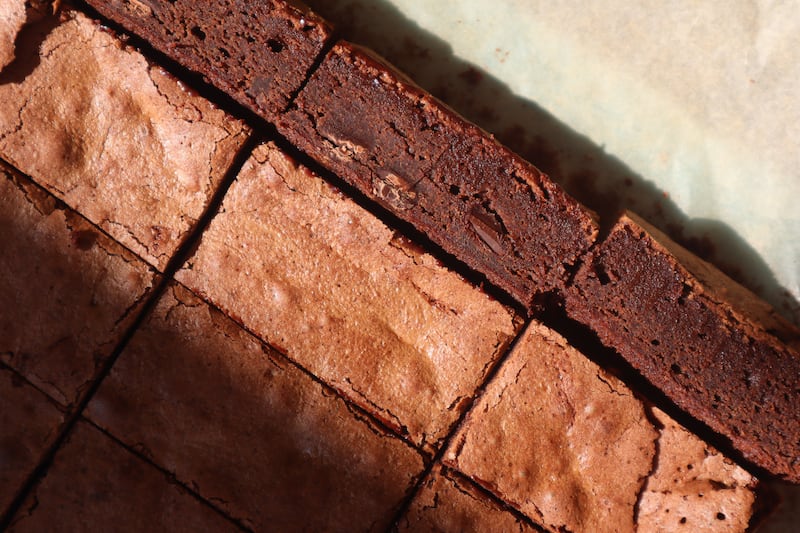Brownies are a classic - and for good reason. Whether you prefer your brownies dense and fudgy, cakey and crumbly or light and moussey, they are the perfect vehicle for a chocolate hit. I tested six different brownie recipes in one day (Nigella Lawson, Stella Parks, Melissa Weller, Nicola Lamb, BBC Good Food and Nigel Slater), and each delivered something a little different in terms of flavour and texture. Having spent the day eating brownies and sipping black coffee, by the time I got around to developing my own recipe, I felt that an espresso brownie would hit the spot.
Mixing method
The most common method used for making brownie batter starts by whipping the eggs and sugar together, either in the bowl of a stand mixer with the whisk attachment, or using a handheld beater or whisk. The degree to which you whisk the eggs and sugar impacts the final texture of the brownie: if you whisk for six or more minutes (as in Nicola Lamb’s and Stella Parks’s recipes) you’re likely to end up with a sabayon, which is a thick, voluminous mousse (not dissimilar to a meringue) that will produce a lighter, more aerated brownie. If you only whisk the eggs and sugar to combine, you won’t incorporate as much air, and you will therefore end up with a denser, fudgier brownie. I take the Goldilocks approach, whisking the eggs and sugar until light and fluffy, but not mousse-like.
Combining this egg mixture with the melted chocolate and butter and finally, dry ingredients, should be done with a light hand (I find a whisk the most effective way to fold the two mixtures together) to avoid knocking out air. I also recommend sieving the dry ingredients over the remaining ingredients (even if not specified in the recipe), as cocoa powder often clumps together, and these lumps will be hard to work out without overmixing the batter.
Some recipes (Melissa Weller’s and Nigella Lawson’s) take a more straightforward approach where the chocolate and butter were melted together, and the remaining ingredients were added directly into this bowl one by one, whisking between each addition. These recipes produced a denser, fudgier brownie, as very little air was incorporated during the mixing.
READ MORE
Nigel Slater’s recipe was the only one that used the “creaming” method (beating the butter and sugar together first until light and fluffy, before incorporating the remaining ingredients), and it produced a surprisingly fudgy brownie, but one that was very different texturally to the other recipes.

Baking
It can be tricky to determine when your brownies are ready to come out of the oven: underbake them, and they will be too soft to cut into squares, but overbake them and they will be dry and unpleasant to eat. I find that it’s good to start with a 15-minute timer, and then check every 3 minutes after that until there is a slight wobble when you shake the tray, but not a violent jiggle. If you want to get nice clean edges on your brownies, allow them to cool fully before chilling in the fridge overnight, then use a hot, clean sharp knife (dipping in boiling water and wiping clean with kitchen roll each time).
Ingredients
An equal proportion of chocolate to butter (1:1) seems to be the standard for most of the recipes I tested, except for Stella Parks, who doubles the amount of butter to chocolate. The higher fat content of the extra butter produced a really lovely silky texture, and Parks boosted the flavour complexity with brown butter, brown sugar, a higher proportion of cocoa, vanilla and salt. The ratio of dry ingredients (flour, cocoa, salt) to total batter varied from 10 per cent to 18 per cent, with a higher percentage of dry ingredients producing a firmer, more structurally sound brownie.
You can make brownies with just flour (and no cocoa), but I prefer the recipes that use both, for a more intense chocolatey flavour. I am in favour of any and all “mix-ins” when it comes to brownies: chocolate chips, nuts, praline - or even Ottolenghi’s wonderful recipe for tahini and halva brownies that I make regularly. Beyond adding flavour (or in the case of chocolate chips, ramping up the chocolate hit), mix-ins also contribute to the structure of the brownie.
I find that a good-quality dark or semi-sweet chocolate works best for the batter of the brownie - anywhere between 55 per cent and 65 per cent. For the mix-ins, I like a slightly lower percentage milk chocolate, about 40 per cent.
I used salted butter for my brownies, but if you’re using unsalted, just add an extra pinch of salt.
Espresso Chocolate Brownie Recipe
References:
Nigella Lawson: How to be a Domestic Goddess
Nicola Lamb: Kitchen Projects Substack



















